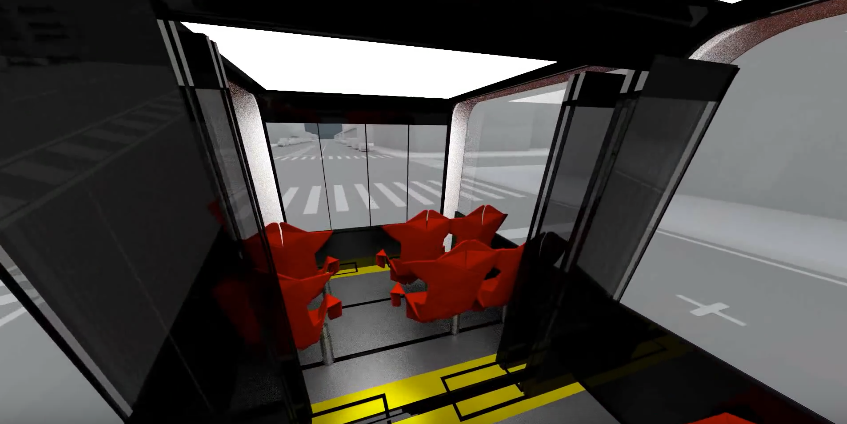Part mass transit, part personal mobility, the Next Future Transportation system is designed to act as an efficient, coordinated network that shuttles folks from door to door. Still in the early concept stages, the design features a series of modular, self-driving electric pods that pick passengers up on demand and link together in bus-like form on the journey to get each of them from point A to B as efficiently as possible.
Italian industrial designer and Next Future Transportation Inc. founder Tommaso Gecchelin imagines our transportation future combining the best attributes of current transportation methods while trimming some fat. He envisions a set of self-driving modules that operate on existing roadways. Unlike current public transportation systems, there are no defined routes, and users order up transportation at the touch of a mobile app. Each module measures 8.8 feet (2.7 m) in length and holds up to 10 people (six seats plus standing room for four).

Because the Next Future system relies on existing roadways, it avoids the need for any added physical infrastructure, such as rails. Instead, its infrastructure is purely virtual, consisting of an advanced, cloud-based routing system that not only drives the autonomous pods to and fro but also coordinates all pods in the system, both private and public, linking swarms together wherever possible to cut traffic, optimize occupancy and ensure the most energy-efficient performance.The modules attach and detach while in motion, and the automatic doors connect the interiors so that passengers can move freely between pods, much like they'd move from car to car on a train. Not only is this interior mobility useful for getting up and stretching or accessing amenities on other modules, but it's a necessary part of the ride – when it's time for you to split off from the greater train toward your destination, you exit to a separate module and go your separate way.

Unlike a bus or train, which runs the same route no matter how few people are on it, the Next system sends individual modules where they're needed and links them in high-traffic areas. Gecchelin even imagines passengers ordering up service pods, such as bathrooms, restaurants or shops, which would automatically locate and join the existing vehicle, allowing said passenger to access needed services without stopping.In a hypothetical travel scenario, you order a Next module with your smartphone app. It picks you up at home and rolls through your neighborhood to the main thoroughfare, where it links up with a multi-module train. If you're going a long distance, you sit back and enjoy the ride, maybe order up a restaurant or bar module. If you have a relatively short journey, an empty pod joins up with the train and the app prompts you to move to this pod, which splits off and drops you at your destination.
Does all that sound a little out there? As we said from the get-go, it is still just an early concept. The design appears to be more than just one designer's wild flight of fancy, though; Gecchelin has incorporated Next Future in Silicon Valley and taken on a CEO and advisory board. The first Next design came out in 2012, and this year the company revealed version 3.0. It plans to work on prototypes with hopes of launching a viable system by 2020.
We won't be holding our breath waiting for Next systems to start revolutionizing cities within the decade, but the design does spark an interesting conversation about future mobility systems. It's a little hard to imagine boxy pods zipping and swarming in all directions around the city grid while fighting through existing car traffic, but we do like how the design combines elements of personalized, point-to-point transportation, car sharing, and efficient, gridlock-reducing mobility. That's all on paper, of course, but it's an interesting alternative compared to more established paradigms: self-driving personal automobiles, existing public transportation options, "last mile" personal mobility devices, etc.
Since this concept is still so young, we won't get into all the claimed advantages and statistics, but you can learn more about those projected benefits on Next's website. It has a few infographics showing how the system could benefit various user groups.
The video below provides a quick look at the Next v3.0 in action, offering a nice visualization of how the system would work from the user's perspective. Take a look and let us know what you think: intriguing vision for future mobility or problem-riddled non-starter?
Source: Next Future












